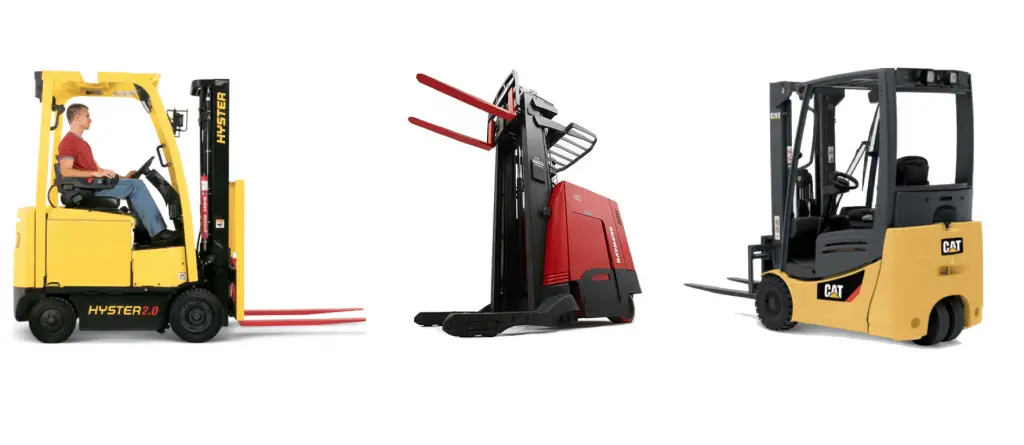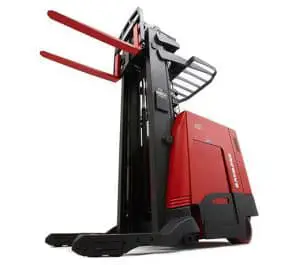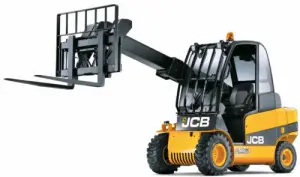Types of forklifts – Lift trucks demystified
Types of forklifts in warehouses today

Are you new to the materials handling business? Or do you need a refresher on types of forklifts? Want to learn about the different types of lift truck? This is your guide to what they are and what do they do.
Counterbalance Forklifts
Counterbalance forklift trucks are the most common type of forklift (sometimes called a lift truck). They are the kind of forklift that most people think of when they are describing a forklift.
On a counterbalance lift truck, the forks stick out from the front of the truck. The forklift can be driven up to the location of the load it will lift or or racking it will access a pallet from.
Counterbalance trucks have a variety of engine types:
- Electric
- Propane
- Fuel cell
- Diesel or Gasoline (internal combustion)
As the term indicates, a counterbalance truck uses a counter-weight design. At the back of the forklift is a weight that counteracts the load lifted on the forks at the front. In the case of electric counterbalance forklifts, are able to operate with a smaller counterweight as the battery serves as ballast as well as a source of power.
3-Wheel Counterbalance Forklift
3 wheel counterbalance lift trucks are similar to counterbalance lift trucks however ta single wheel in the center of the rear of the truck provides enhanced manoeuvrability.
These trucks are ideal for use where space is tight and excellent manoeuvrability is needed. They are also suited for inside or outside as well as loading rack (warehouse shelving).
Reach Truck

Reach trucks, sometimes referred to as Reach-Fork trucks, were invented by the Raymond Corp. in 1951.
They are designed primarily for warehouse operation. Reach trucks can provide maximum lift height with excellent manoeuvrability in closed quarters.
The name references the the forks that can reach past the stabilizing elements of the truck and extend into pallet rack storage (warehouse shelving).
This reaching ability combined with the stabilizing legs allows reach trucks to lift loads to great heights (more than 30 feet or 10 meters). They can operate in extremely tight work environments where the working aisle between racking is very narrow .
The stabilizing legs and batteries on a reach truck eliminate the need for a counterbalance weight on the forklift.
Some reach truck manufacturers design their reach forklifts so that a tilting cab allows a better position for the operator to see what is going on as they operate the load.
For more visibility, some reach trucks have cameras on the forks that send video to a LCD screen in front of the operator to help them navigate.
They are more suited for use inside a warehouse and are not ideal to work outside. Low under-carriage clearance can often create problems on uneven working surfaces common in outdoor environments.
Hand Pallet Truck
Hand pallet trucks, sometimes referred to as Pump Trucks, are non-powered warehouse tools that can move pallets and their loads up to 7700+ lbs (3500 kg).
The operator pushed the forks into the pallet openings, and then uses the handle (pumping up and down) to raise the forks (and load) off the ground. They then manually pull or push the truck to move the load.
The front wheels of the hand pallet truck are mounted inside the end of the forks, and as the hydraulic jack is raised, the forks are separated vertically from the front wheels, forcing the load upward until it clears the floor. The pallet is only lifted enough to clear the floor for subsequent travel.
Here are the types of hand pallet trucks in use today:
- Standard pallet
- Euro pallet
- Low profile
- Foldable
- All terrain
- Wide fork-spread
- Long forked
- Short forked
- Narrow fork-spread
- Stainless steel
Electric Pallet Truck
Electric-powered pallet trucks are like hand pallet trucks in that the operator pushed the forks into a pallet to load it, except that instead of manually lifting the load, and electric motor does the work.
Typically, there is a ‘paddle’ control to select forward or reverse direction, and button control to raise or lower the forks.
As with all electric powered trucks, the batteries contained within need to be charged. Often, with a powered pallet truck, the truck has an integral charger meaning that it can be plugged straight into the mains without the need for a stand-alone charger.
Powered pallet trucks operate best on flat and smooth surfaces.
Teletruck
 Teletrucks are specialist forklifts. Instead of a standard straight mast found on counterbalance lift trucks or reach trucks, they have a mast with a boom that can extend. The key benefit of this class of forklift is that they can access both sides of a delivery wagon. The drawbacks is the trucks are more expensive than counterbalance forklifts. There is also increase reliability issues thanks to the complexity of how they are engineered.
Teletrucks are specialist forklifts. Instead of a standard straight mast found on counterbalance lift trucks or reach trucks, they have a mast with a boom that can extend. The key benefit of this class of forklift is that they can access both sides of a delivery wagon. The drawbacks is the trucks are more expensive than counterbalance forklifts. There is also increase reliability issues thanks to the complexity of how they are engineered.
Sideloader
Sideloaders are a class of forklift that can picking up a load from the side as opposed to the front of the lift truck.
These trucks are very good at manipulating wide or long loads. Thing lumber, sheet metal etc. Sideloaders are useful to handle material such as wood, pipe and sheets of various materials.


